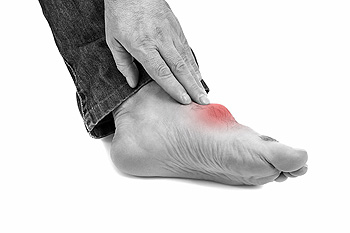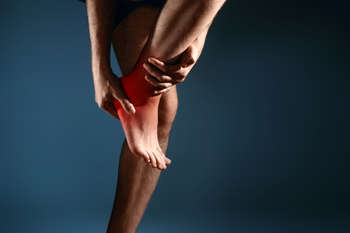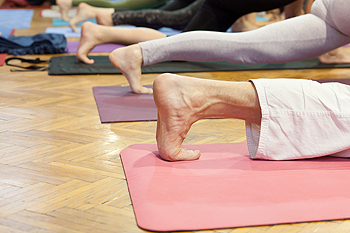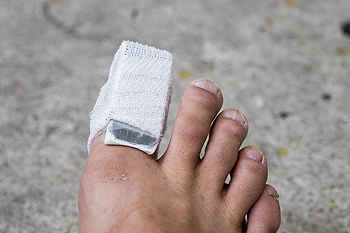 Gout is an inflammatory form of arthritis that often causes a great deal of foot pain for those affected. One common symptom of gout that negatively affects a patient is called gout flares. These flares cause extreme pain in the joints affected by gout, typically in the toes. When crystals form on the joints due to high levels of uric acid, the joints may become both tender and inflamed. The pain felt due to gout can be excruciating if left untreated. Even the slightest touch can cause a patient to feel a great deal of discomfort. Since gout commonly affects the lower extremity regions of the body, it is recommended to visit a podiatrist for professional care and treatment when dealing with this condition.
Gout is an inflammatory form of arthritis that often causes a great deal of foot pain for those affected. One common symptom of gout that negatively affects a patient is called gout flares. These flares cause extreme pain in the joints affected by gout, typically in the toes. When crystals form on the joints due to high levels of uric acid, the joints may become both tender and inflamed. The pain felt due to gout can be excruciating if left untreated. Even the slightest touch can cause a patient to feel a great deal of discomfort. Since gout commonly affects the lower extremity regions of the body, it is recommended to visit a podiatrist for professional care and treatment when dealing with this condition.
Gout is a foot condition that requires certain treatment and care. If you are seeking treatment, contact Bruce Smit, DPM from Frankfort Foot & Ankle Clinic. Our doctor will treat your foot and ankle needs.
What Is Gout?
Gout is a type of arthritis caused by a buildup of uric acid in the bloodstream. It often develops in the foot, especially the big toe area, although it can manifest in other parts of the body as well. Gout can make walking and standing very painful and is especially common in diabetics and the obese.
People typically get gout because of a poor diet. Genetic predisposition is also a factor. The children of parents who have had gout frequently have a chance of developing it themselves.
Gout can easily be identified by redness and inflammation of the big toe and the surrounding areas of the foot. Other symptoms include extreme fatigue, joint pain, and running high fevers. Sometimes corticosteroid drugs can be prescribed to treat gout, but the best way to combat this disease is to get more exercise and eat a better diet.
If you have any questions please feel free to contact our office located in Frankfort, IL . We offer the newest diagnostic and treatment technologies for all your foot and ankle needs.
 The tissue that connects the heel to the calf muscles is referred to as the Achilles tendon. This tendon is responsible for the ability to walk, run, and jump, and these activities may be difficult to perform if it becomes injured or torn. This type of injury can occur as a result of exercising on an uneven surface or from wearing shoes that do not fit properly. Additionally, if the calf muscles are tight, the Achilles tendon may endure stress, and this can possibly lead to a rupture. Common symptoms many patients experience can include severe pain in the calf difficulty in pointing and flexing the affected foot. If you have endured an injury to the Achilles tendon, it is advised that you consult with a podiatrist who can help you with proper treatment options.
The tissue that connects the heel to the calf muscles is referred to as the Achilles tendon. This tendon is responsible for the ability to walk, run, and jump, and these activities may be difficult to perform if it becomes injured or torn. This type of injury can occur as a result of exercising on an uneven surface or from wearing shoes that do not fit properly. Additionally, if the calf muscles are tight, the Achilles tendon may endure stress, and this can possibly lead to a rupture. Common symptoms many patients experience can include severe pain in the calf difficulty in pointing and flexing the affected foot. If you have endured an injury to the Achilles tendon, it is advised that you consult with a podiatrist who can help you with proper treatment options.
Achilles tendon injuries need immediate attention to avoid future complications. If you have any concerns, contact Bruce Smit, DPM of Frankfort Foot & Ankle Clinic. Our doctor can provide the care you need to keep you pain-free and on your feet.
What Is the Achilles Tendon?
The Achilles tendon is a tendon that connects the lower leg muscles and calf to the heel of the foot. It is the strongest tendon in the human body and is essential for making movement possible. Because this tendon is such an integral part of the body, any injuries to it can create immense difficulties and should immediately be presented to a doctor.
What Are the Symptoms of an Achilles Tendon Injury?
There are various types of injuries that can affect the Achilles tendon. The two most common injuries are Achilles tendinitis and ruptures of the tendon.
Achilles Tendinitis Symptoms
Rupture Symptoms
Treatment and Prevention
Achilles tendon injuries are diagnosed by a thorough physical evaluation, which can include an MRI. Treatment involves rest, physical therapy, and in some cases, surgery. However, various preventative measures can be taken to avoid these injuries, such as:
If you have any questions please feel free to contact our office located in Frankfort, IL . We offer the newest diagnostic tools and technology to treat your foot and ankle needs.
 A common foot condition that affects the toes is referred to as hammertoe. The middle joint in the second toe curls up, forcing the end of the toe to bend downward. The affected toe can resemble a hammer, and additional symptoms may include pain and discomfort. Corns and blisters can also develop on top of the extended toe. Hammertoe can occur as a result of genetic factors, and from wearing shoes that do not have adequate room for the toes to move freely in. There may be an existing bunion that can cause pressure on the affected toes. Many patients find it beneficial to perform specific foot and toe stretches that may help to relieve a portion of the pain. In severe cases, surgery may be recommended that can permanently straighten the toes. If you are afflicted with hammertoe, it is strongly advised that you are under the care of a podiatrist who can offer you correct treatment techniques.
A common foot condition that affects the toes is referred to as hammertoe. The middle joint in the second toe curls up, forcing the end of the toe to bend downward. The affected toe can resemble a hammer, and additional symptoms may include pain and discomfort. Corns and blisters can also develop on top of the extended toe. Hammertoe can occur as a result of genetic factors, and from wearing shoes that do not have adequate room for the toes to move freely in. There may be an existing bunion that can cause pressure on the affected toes. Many patients find it beneficial to perform specific foot and toe stretches that may help to relieve a portion of the pain. In severe cases, surgery may be recommended that can permanently straighten the toes. If you are afflicted with hammertoe, it is strongly advised that you are under the care of a podiatrist who can offer you correct treatment techniques.
Hammertoes can be a painful condition to live with. For more information, contact Bruce Smit, DPM of Frankfort Foot & Ankle Clinic. Our doctor will answer any of your foot- and ankle-related questions.
Hammertoe
Hammertoe is a foot deformity that occurs due to an imbalance in the muscles, tendons, or ligaments that normally hold the toe straight. It can be caused by the type of shoes you wear, your foot structure, trauma, and certain disease processes.
Symptoms
Risk Factors
Treatment
If you have hammertoe, you should change into a more comfortable shoe that provides enough room for your toes. Exercises such as picking up marbles may strengthen and stretch your toe muscles. Nevertheless, it is important to seek assistance from a podiatrist in order to determine the severity of your hammertoe and see which treatment option will work best for you.
If you have any questions, please feel free to contact our office located in Frankfort, IL . We offer the newest diagnostic and treatment technologies for all your foot care needs.
Read more about Hammertoe A fungal infection that occurs on the skin of the feet is known as athlete’s foot. It can cause severe itching and blistering. It can happen as a result of wearing shoes and socks that are wet for extended periods of time, causing the fungus to grow. This skin condition can be spread from one person to another when public pools are visited. Additionally, this fungus may live and thrive in communal shower rooms and locker rooms, which is why it is suggested to wear appropriate shoes while in these areas. Effective prevention methods can include wearing clean socks and shoes, washing and drying the feet daily, and applying an antifungal powder. If you feel you have contracted this ailment, please consult with a podiatrist who can help you to feel better.
A fungal infection that occurs on the skin of the feet is known as athlete’s foot. It can cause severe itching and blistering. It can happen as a result of wearing shoes and socks that are wet for extended periods of time, causing the fungus to grow. This skin condition can be spread from one person to another when public pools are visited. Additionally, this fungus may live and thrive in communal shower rooms and locker rooms, which is why it is suggested to wear appropriate shoes while in these areas. Effective prevention methods can include wearing clean socks and shoes, washing and drying the feet daily, and applying an antifungal powder. If you feel you have contracted this ailment, please consult with a podiatrist who can help you to feel better.
Athlete’s foot is an inconvenient condition that can be easily reduced with the proper treatment. If you have any concerns about your feet and ankles, contact Bruce Smit, DPM from Frankfort Foot & Ankle Clinic. Our doctor will treat your foot and ankle needs.
Athlete’s Foot: The Sole Story
Athlete's foot, also known as tinea pedis, can be an extremely contagious foot infection. It is commonly contracted in public changing areas and bathrooms, dormitory style living quarters, around locker rooms and public swimming pools, or anywhere your feet often come into contact with other people.
Solutions to Combat Athlete’s Foot
Athlete’s foot can cause many irritating symptoms such as dry and flaking skin, itching, and redness. Some more severe symptoms can include bleeding and cracked skin, intense itching and burning, and even pain when walking. In the worst cases, Athlete’s foot can cause blistering as well. Speak to your podiatrist for a better understanding of the different causes of Athlete’s foot, as well as help in determining which treatment options are best for you.
If you have any questions please feel free to contact our office located in Frankfort, IL . We offer the newest diagnostic and treatment technologies for all your foot and ankle needs.
 The most common form of ankle pain is known as an ankle sprain. It can happen from suddenly stepping off of a curb, which may result in the ankle rolling to one side. When this occurs, the ligaments may stretch beyond their normal limitations, and this may cause severe pain and discomfort. The recovery time generally depends on how extreme the sprain is. A mild injury can take up to three weeks to completely heal, and most daily activities can be completed. A moderate sprain can take approximately six weeks to heal, and activities may have to be limited. A severe injury can take several months to heal, and many activities may have to be avoided. If you have symptoms of an ankle sprain, please consult with a podiatrist who can diagnose and treat this condition.
The most common form of ankle pain is known as an ankle sprain. It can happen from suddenly stepping off of a curb, which may result in the ankle rolling to one side. When this occurs, the ligaments may stretch beyond their normal limitations, and this may cause severe pain and discomfort. The recovery time generally depends on how extreme the sprain is. A mild injury can take up to three weeks to completely heal, and most daily activities can be completed. A moderate sprain can take approximately six weeks to heal, and activities may have to be limited. A severe injury can take several months to heal, and many activities may have to be avoided. If you have symptoms of an ankle sprain, please consult with a podiatrist who can diagnose and treat this condition.
Ankle pain can be caused by a number of problems and may be potentially serious. If you have ankle pain, consult with Bruce Smit, DPM from Frankfort Foot & Ankle Clinic. Our doctor will assess your condition and provide you with quality foot and ankle treatment.
Ankle pain is any condition that causes pain in the ankle. Due to the fact that the ankle consists of tendons, muscles, bones, and ligaments, ankle pain can come from a number of different conditions.
Causes
The most common causes of ankle pain include:
Symptoms
Symptoms of ankle injury vary based upon the condition. Pain may include general pain and discomfort, swelling, aching, redness, bruising, burning or stabbing sensations, and/or loss of sensation.
Diagnosis
Due to the wide variety of potential causes of ankle pain, podiatrists will utilize a number of different methods to properly diagnose ankle pain. This can include asking for personal and family medical histories and of any recent injuries. Further diagnosis may include sensation tests, a physical examination, and potentially x-rays or other imaging tests.
Treatment
Just as the range of causes varies widely, so do treatments. Some more common treatments are rest, ice packs, keeping pressure off the foot, orthotics and braces, medication for inflammation and pain, and surgery.
If you have any questions, please feel free to contact our office located in Frankfort, IL . We offer the newest diagnostic and treatment technologies for all your foot care needs.
 Many people enjoy the feeling of stretching their feet. Stretching helps the overall foot to feel good, in addition to improving mobility and flexibility. There are specific stretches that are suggested for certain foot conditions such as bunions and plantar fasciitis. The plantar fascia is the portion of tissue which connects the heel to the toes, and it is located on the bottom of the foot. It may become stronger when the toes are pointed and flexed, or when the sole of the foot is rolled on a bottle. Bunions may be caused by wearing shoes that do not have adequate room for the toes to move freely in. It is beneficial to place the ankle across the opposite thigh, and gently rotate the toes to each side. When patients stand for the majority of the day, the toes may become cramped and stiff, and existing discomfort may be relieved when the toes are stretched. For additional information about how to properly perform foot stretches, please consult with a podiatrist.
Many people enjoy the feeling of stretching their feet. Stretching helps the overall foot to feel good, in addition to improving mobility and flexibility. There are specific stretches that are suggested for certain foot conditions such as bunions and plantar fasciitis. The plantar fascia is the portion of tissue which connects the heel to the toes, and it is located on the bottom of the foot. It may become stronger when the toes are pointed and flexed, or when the sole of the foot is rolled on a bottle. Bunions may be caused by wearing shoes that do not have adequate room for the toes to move freely in. It is beneficial to place the ankle across the opposite thigh, and gently rotate the toes to each side. When patients stand for the majority of the day, the toes may become cramped and stiff, and existing discomfort may be relieved when the toes are stretched. For additional information about how to properly perform foot stretches, please consult with a podiatrist.
Stretching the feet is a great way to prevent injuries. If you have any concerns with your feet consult with Bruce Smit, DPM from Frankfort Foot & Ankle Clinic. Our doctor will assess your condition and provide you with quality foot and ankle treatment.
Stretching the Feet
Being the backbone of the body, the feet carry your entire weight and can easily become overexerted, causing cramps and pain. As with any body part, stretching your feet can serve many benefits. From increasing flexibility to even providing some pain relief, be sure to give your feet a stretch from time to time. This is especially important for athletes or anyone performing aerobic exercises, but anyone experiencing foot pain or is on their feet constantly should also engage in this practice.
Great ways to stretch your feet:
Individuals who tend to their feet by regular stretching every day should be able to minimize foot pain and prevent new problems from arising.
If you have any questions, please feel free to contact our office located in Frankfort, IL . We offer the newest diagnostic and treatment technologies for all your foot care needs.
 A broken toe is considered to be one of the most common types of fractures. The toes consist of several small bones, which can easily become broken. It can happen from dropping a heavy object on your toe, or from possibly stubbing it against a piece of furniture. A broken toe generally causes difficulty walking, and can take between four to six weeks to completely heal. Many patients choose to use a treatment method that is referred to as buddy taping, which may be effective for mild fractures. This consists of taping the affected toe to the toe next to it. This treatment method can provide the support that is needed as the healing process occurs. If you have broken your toe, it is suggested that you consult with a podiatrist who can treat mild or severely fractured toes.
A broken toe is considered to be one of the most common types of fractures. The toes consist of several small bones, which can easily become broken. It can happen from dropping a heavy object on your toe, or from possibly stubbing it against a piece of furniture. A broken toe generally causes difficulty walking, and can take between four to six weeks to completely heal. Many patients choose to use a treatment method that is referred to as buddy taping, which may be effective for mild fractures. This consists of taping the affected toe to the toe next to it. This treatment method can provide the support that is needed as the healing process occurs. If you have broken your toe, it is suggested that you consult with a podiatrist who can treat mild or severely fractured toes.
A broken toe can be very painful and lead to complications if not properly fixed. If you have any concerns about your feet, contact Bruce Smit, DPM from Frankfort Foot & Ankle Clinic. Our doctor will treat your foot and ankle needs.
What to Know About a Broken Toe
Although most people try to avoid foot trauma such as banging, stubbing, or dropping heavy objects on their feet, the unfortunate fact is that it is a common occurrence. Given the fact that toes are positioned in front of the feet, they typically sustain the brunt of such trauma. When trauma occurs to a toe, the result can be a painful break (fracture).
Symptoms of a Broken Toe
Generally, it is best to stay off of the injured toe with the affected foot elevated.
Severe toe fractures may be treated with a splint, cast, and in some cases, minor surgery. Due to its position and the pressure it endures with daily activity, future complications can occur if the big toe is not properly treated.
If you have any questions please feel free to contact our office located in Frankfort, IL . We offer the newest diagnostic and treatment technologies for all your foot and ankle needs.
 An ankle sprain may occur after suddenly twisting it. This may happen from falling, or from unexpectedly stepping off of a curb. It occurs as a result of ligaments stretching beyond their normal capabilities, and can cause severe pain and discomfort. Many people who enjoy running may ignore the symptoms of a sprained ankle, and will continue to run. This is not recommended, as it may impact the gait, which can lead to changes in the running style. After a proper diagnosis is performed, which generally involves having an X-ray taken, proper treatment can begin. This may consist of wrapping the ankle in an elastic bandage, which can provide the stability that is necessary as the healing process begins. Gentle stretching exercises may gradually be introduced, which may be helpful in strengthening the overall foot. Please consult with a podiatrist if you have sprained your ankle so they can recommend the best type of treatment method for you.
An ankle sprain may occur after suddenly twisting it. This may happen from falling, or from unexpectedly stepping off of a curb. It occurs as a result of ligaments stretching beyond their normal capabilities, and can cause severe pain and discomfort. Many people who enjoy running may ignore the symptoms of a sprained ankle, and will continue to run. This is not recommended, as it may impact the gait, which can lead to changes in the running style. After a proper diagnosis is performed, which generally involves having an X-ray taken, proper treatment can begin. This may consist of wrapping the ankle in an elastic bandage, which can provide the stability that is necessary as the healing process begins. Gentle stretching exercises may gradually be introduced, which may be helpful in strengthening the overall foot. Please consult with a podiatrist if you have sprained your ankle so they can recommend the best type of treatment method for you.
Although ankle sprains are common, they aren’t always minor injuries. If you need your ankle injury looked at, contact Bruce Smit, DPM from Frankfort Foot & Ankle Clinic. Our doctor can provide the care you need to keep you pain-free and on your feet.
How Does an Ankle Sprain Occur?
Ankle sprains are the result of a tear in the ligaments within the ankle. These injuries may happen when you make a rapid shifting movement while your foot is planted. A less common way to sprain your ankle is when your ankle rolls inward while your foot turns outward.
What Are the Symptoms?
Preventing a Sprain
Treatment of a Sprain
In many cases, the RICE method (Rest, Ice, Compression, and Elevate) is used to treat ankle sprains. However, you should see a podiatrist to see which treatment option would work best with your injury. In severe cases, surgery may be required.
It is important to ask your doctor about rehab options after you receive treatment for your injury. Stretching, strength training, and balance exercises may help the ankle heal while also preventing further injury.
If you have any questions, please feel free to contact our office located in Frankfort, IL . We offer the newest diagnostic and treatment technologies for all your foot care needs.